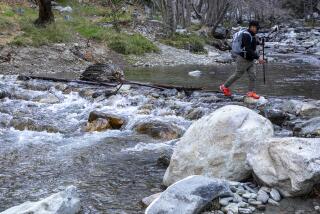Wind Shift Slows Wildfire at Mesa Verde Park in Colorado
- Share via
MESA VERDE NATIONAL PARK, Colo. — A wind shift and thinner vegetation helped slow a wildfire Tuesday that has carved an eerie landscape of burnt tree trunks and blackened ground across one-third of the nation’s largest archeological preserve.
The Mesa Verde National Park fire stalled at an area damaged by blazes in 1972 and 1996, where shrubs were shorter and spaced farther apart, said Tim Oliverious, a National Park Service fire management officer.
Firefighters lit a fire in a strip of thick vegetation between the two old fire sites, hoping to prevent the current blaze from spreading. By Tuesday, the fire had burned 22,630 acres, including 18,630 acres of parkland.
Scattered puffs of smoke could be seen across the park early in the day, rather than a giant plume that had dominated the southwestern Colorado sky for days.
Calmer weather and higher humidity in the afternoon allowed about 700 firefighters working in 90-plus-degree weather to make progress against the blaze. It was about 15% contained at midday, officials said.
But incident commander Joe Hartman said the fire was still burning briskly on the Ute Mountain Ute Indian reservation. “There are still some angry flames out there that can jump around,” he said.
Gov. Bill Owens declared a state of disaster emergency for the fire area and dispatched about two dozen Colorado National Guard soldiers plus equipment to the scene. The declaration frees up state resources to help local governments.
The fire poses special challenges for firefighters and archeologists, who are working side by side to protect mounds of rocks and rubble--artifacts from ancestral Pueblo Indians, who thrived amid the rugged mesas and canyons between AD 600 and 1300.
More to Read
Sign up for Essential California
The most important California stories and recommendations in your inbox every morning.
You may occasionally receive promotional content from the Los Angeles Times.













